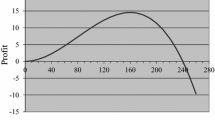Abstract
The optimal tour length of a non-Euclidean traveling salesman problem (TSP) can be estimated using the locations of vertices and the circuity factor. In this paper, we propose a method to estimate the optimal tour length of a non-Euclidean TSP using Sammon mapping. While providing accuracy comparable to the approach using the circuity factor, this new method has a number of advantages.













Similar content being viewed by others
Data availibility statement
The datasets generated during and/or analysed as part of the current study are available from the corresponding author upon request.
References
Beardwood, J., Halton, J.H., Hammersley, J.M.: The shortest path through many points. In: Mathematical Proceedings of the Cambridge Philosophical Society. vol. 55(4), pp. 299–327. Cambridge University Press, Cambridge (1959). https://doi.org/10.1017/S0305004100034095
Boeing, GOSMnx: new methods for acquiring, constructing, analyzing, and visualizing complex street networks. Comput. Environ. Urban Syst. 65, 126–139 (2017)
Chien, T.W.: Operational estimators for the length of a traveling salesman tour. Comput. Oper. Res. 19(6), 469–478 (1992)
Daganzo, C.F.: The length of tours in zones of different shapes. Transp. Res. Part B Methodol. 18(2), 135–145 (1984)
Hagberg, A., Swart, P., Schult Chult, D.: Exploring Network structure, Dynamics, and Function Using NetworkX. Technical report, Los Alamos National Lab.(LANL), Los Alamos, NM, USA (2008)
Helsgaun, K.: An Effective Implementation of the Lin-Kernighan traveling salesman heuristic. Eur. J. Oper. Res. 126(1), 106–130 (2000)
Hoffman, K.L., Padberg, M., Rinaldi, G., et al.: Traveling salesman problem. Encycl. Oper. Res. Manag. Sci. 1, 1573–1578 (2013)
Laporte, G., Palekaz, U.: Some applications of the clustered travelling salesman problem. J. Oper. Res. Soc. 53(9), 972–976 (2002)
Merchán, D., Winkenbach, M.: An empirical validation and data-driven extension of continuum approximation approaches for urban route distances. Networks 73(4), 418–433 (2019)
Pedregosa, F., Varoquaux, G., Gramfort, A., Michel, V., Thirion, B., Grisel, O., Blondel, M., Prettenhofer, P., Weiss, R., Dubourg, V., et al.: Scikit-learn: machine learning in python. J. Mach. Learn. Res. 12, 2825–2830 (2011)
Pekalska, E.M. et al.: A New method of generalizing Sammon Mapping with application to algorithm speed-up. In: Heijen NL. ASCI, pp. 221–228 (1999)
Sammon, J.W.: A nonlinear mapping for data structure analysis. IEEE Trans. Comput. 100(5), 401–409 (1969)
Virtanen, P., Gommers, R., Oliphant, T.E., Haberland, M., Reddy, T., Cournapeau, D., Burovski, E., Peterson, P., Weckesser, W., Bright, J., et al.: SciPy 10: fundamental algorithms for scientific computing in python. Nat. Methods 17(3), 261–272 (2020)
Wang, C.J., Fang, H., Wang, H.: ESammon: a computationaly enhanced Sammon mapping based on data density. In: 2016 International Conference on Computing, Networking and Communications (ICNC), pp. 1–5. IEEE (2016)
Yang, H., et al.: Expected length of the shortest path of the traveling salesman problem in 3D space. J. Adv. Transp. (2022). https://doi.org/10.1155/2022/4124950
Author information
Authors and Affiliations
Corresponding author
Additional information
Publisher's Note
Springer Nature remains neutral with regard to jurisdictional claims in published maps and institutional affiliations.
Appendix
Appendix
For the 1 km\(^2\) São Paulo road map instances in Fig. 4, after obtaining the coefficients of the \(\sqrt{NA_{Sammon}}\) model using linear regression, we also generate the two residual plots in Fig. 14 below for two variables in the predictor set: number of vertices, N, and the convex hull area based on projected vertex coordinates in a Sammon map, \(A_{Sammon}\).
There is no obvious pattern in the residual plot with respect to \(A_{Sammon}\), and the value of the residual does not seem to depend on the value of \(A_{Sammon}\). For the residual plot with respect to N, one may find some degree of heteroskedasticity, and question if an increase in N will decrease the predictive ability of the \(\sqrt{NA_{Sammon}}\) predictor. To address this concern, we include the residual plot for the variable N for the 4 km\(^2\) São Paulo road map instances in Fig. 15, and we observe that it is not the case that the residual grows as N increases.
Rights and permissions
Springer Nature or its licensor holds exclusive rights to this article under a publishing agreement with the author(s) or other rightsholder(s); author self-archiving of the accepted manuscript version of this article is solely governed by the terms of such publishing agreement and applicable law.
About this article
Cite this article
Kou, S., Golden, B. & Poikonen, S. Optimal TSP tour length estimation using Sammon maps. Optim Lett 17, 89–105 (2023). https://doi.org/10.1007/s11590-022-01937-y
Received:
Accepted:
Published:
Issue Date:
DOI: https://doi.org/10.1007/s11590-022-01937-y







